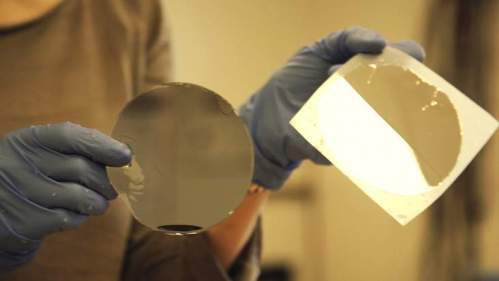Categories: Featured Articles » Interesting electrical news
Number of views: 10373
Comments on the article: 1
Self-adhesive solar panels
“The solar battery can be glued to anything from portable power supplies for gadgets to smart clothes and even autonomous space suits of astronauts,” said Xiaolin Zheng, an article published in Scientific Reports.
The combination of thin-film electronics with new solar panels will open up opportunities for the creation of new technical devices, and this is only the first stage in the development of this technology. The technology “tear off and decal” can be used completely versatile, assured the head of the team of physicists at Stanford University Xiaolin Zheng.

Zheng with like-minded people developed and reproduced real solar-battery stickers, which were the result of experiments with films of silicon oxide and nickel of nanometer thickness. Scientists explain that solar panels traditionally can only work normally on very, very flat surfaces, on special substrates, such as glass or silicon.
The problem is that if you use other substrates, they will not work because of the poor flatness of the surface, low resistance to high temperatures and chemical treatment. This tradition greatly limits the scope of application of solar power sources with a simultaneous increase in their cost.
The developers managed to get rid of these shortcomings in their thin-film batteries due to the original approach. The main idea was to separate the finished battery from the silicon wafer so that any substrate could then be used, regardless of its flatness and stiffness.
The scientists were prompted by the technology for producing graphene by its discoverers Game and Novoselov. By a similar technique, Xiaolin Chzhen and colleagues applied the thinnest nickel film (300 nm) to a plate of a mixture of silicon oxide and pure silicon by electron beam evaporation.
The next step on the resulting two-layer structure was applied to the active part of a thin-film solar battery and a protective polymer layer to prevent contact of the active part with water. Then a thermal scotch tape was glued to one edge, and the plate was placed in a water bath at room temperature.
A few minutes later, scientists separated the edge of the tape so that water molecules penetrated between the nickel and the plate, then raising the strip of thermal tape, physicists completely separated the entire film of the resulting solar battery from the silicon plate. At the stage of complete separation of the film, the scientists preheated the entire structure to 90 degrees to weaken the adhesion.
After separation from the plate, the film can be glued to the target surface with glue, and the plate itself can be used again to form the next battery sticker.

It is important to note that the obtained film solar cells show almost the same efficiency before and after separation of the film from the substrate. Measurements showed that the current and voltage before and after the process of sizing on a stainless steel sheet or on soda-lime glass are indistinguishable, it is understood that no damage occurs during transfer of the sticker to any surface.
Average measurements of performance indicators of more than 20 solar panels with an area of 0.05 sq. Cm and 0.28 sq. Cm, respectively, showed efficiency = 7.4 ± 0.5% and 5.2 ± 0.1% before the plywood process and efficiency = 7.6 ± 0.5% and n = 5.3 ± 0.1% after plywood. The difference in efficiency between cells of different sizes is due to the high resistance of the batteries connected in series.
However, it is more important that both solar panels have almost identical performance indicators before and after the sizing process, and the deviation is only 5%, which is within the measurement error. These results illustrate several key advantages of this technology: versatility in the choice of substrate, high quality of the original design, simplicity and scalability of the process, as well as additional savings on reusable use of original silicon substrates.
Zheng claims that such film solar panels can be glued to any surface: glass, fabric, paper, or any other non-typical material for photoelectronics, even on the walls of houses. And in each case, the battery will generate the same amount of electricity as the traditional solar panels of the previous technology, while maintaining an efficiency of 7.5%.
Plus, the battery-sticker easily bends, and this does not lead to breakdowns or to a decrease in efficiency. Scientists predict that this remarkable property at low cost will allow the use of new solar panels - stickers as power sources for smart clothes and other electronic devices where flexibility is important.
See also at bgv.electricianexp.com
:

